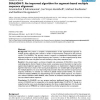Free Online Productivity Tools
i2Speak
i2Symbol
i2OCR
iTex2Img
iWeb2Print
iWeb2Shot
i2Type
iPdf2Split
iPdf2Merge
i2Bopomofo
i2Arabic
i2Style
i2Image
i2PDF
iLatex2Rtf
Sci2ools
BMCBI
2005
2005
DIALIGN-T: An improved algorithm for segment-based multiple sequence alignment
Background: We present a complete re-implementation of the segment-based approach to multiple protein alignment that contains a number of improvements compared to the previous version 2.2 of DIALIGN. This previous version is superior to Needleman-Wunsch-based multialignment programs on locally related sequence sets. However, it is often outperformed by these methods on data sets with global but weak similarity at the primary-sequence level. Results: In the present paper, we discuss strengths and weaknesses of DIALIGN in view of the underlying objective function. Based on these results, we propose several heuristics to improve the segment-based alignment approach. For pairwise alignment, we implemented a fragment-chaining algorithm that favours chains of low-scoring local alignments over isolated high-scoring fragments. For multiple alignment, we use an improved greedy procedure that is less sensitive to spurious local sequence similarities. To evaluate our method on globally related p...
Related Content
| Added | 15 Dec 2010 |
| Updated | 15 Dec 2010 |
| Type | Journal |
| Year | 2005 |
| Where | BMCBI |
| Authors | Amarendran R. Subramanian, Jan Weyer-Menkhoff, Michael Kaufmann, Burkhard Morgenstern |
Comments (0)

